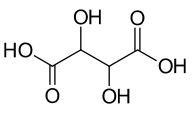Tartaric acid
Tartaric acid, oxalic acid and histamine are the well-recognized pain-inducing agents in the stinging hairs of U. thunbergiana.
Inquire / Order:
manager@chemfaces.com
Technical Inquiries:
service@chemfaces.com
Tel:
+86-27-84237783
Fax:
+86-27-84254680
Address:
1 Building, No. 83, CheCheng Rd., Wuhan Economic and Technological Development Zone, Wuhan, Hubei 430056, PRC
Providing storage is as stated on the product vial and the vial is kept tightly sealed, the product can be stored for up to
24 months(2-8C).
Wherever possible, you should prepare and use solutions on the same day. However, if you need to make up stock solutions in advance, we recommend that you store the solution as aliquots in tightly sealed vials at -20C. Generally, these will be useable for up to two weeks. Before use, and prior to opening the vial we recommend that you allow your product to equilibrate to room temperature for at least 1 hour.
Need more advice on solubility, usage and handling? Please email to: service@chemfaces.com
The packaging of the product may have turned upside down during transportation, resulting in the natural compounds adhering to the neck or cap of the vial. take the vial out of its packaging and gently shake to let the compounds fall to the bottom of the vial. for liquid products, centrifuge at 200-500 RPM to gather the liquid at the bottom of the vial. try to avoid loss or contamination during handling.
Antioxidants (Basel).2023, 12(12):2078.
BMC Complement Med Ther. 2020, 20(1):94.
Thorac Cancer.2023, 14(21):2007-2017.
Antioxidants (Basel).2020, 9(6):466.
Pharmaceuticals (Basel).2024, 17(4):462.
Dermatologica Sinica2024, 42(1):p19-30.
Cell Physiol Biochem.2019, 52(6):1255-1266
World J.Traditional Chinese Med.2024, 10(3):370-382
Sci Rep.2023, 13(1):7475.
Nutrients.2019, 11(11):E2694
Related and Featured Products
Ann Bot. 2006 July; 98(1): 57–65.
Identification of Oxalic Acid and Tartaric Acid as Major Persistent Pain-inducing Toxins in the Stinging Hairs of the Nettle, Urtica thunbergiana[Reference:
WebLink]
The HPLC results showed that the major constituents in the stinging hairs of U. thunbergiana were histamine, oxalic acid and Tartaric acid. However, the well-recognized pain-inducing agents, serotonin and formic acid, existed at a low concentration as estimated by HPLC and/or enzymatic analyses. The behavioural tests showed that 2% oxalic acid and 10% Tartaric acid dramatically elicited persistent pain sensations in rats. In contrast, 10% formic acid and 2% serotonin only elicited moderate pain sensation in the first 10min. Moreover, no significant pain-related behavioural response was observed after injecting 10% acetylcholine and histamine in rats.



